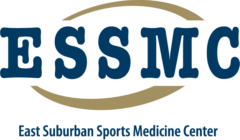Elbow Pain
Medial Epicondylitis (Golfers’ Elbow):
Medial epicondylitis occurs as a result of repetitive micro trauma to the muscles of the forearm. Pain is usually in the medial “inside” aspect of the elbow following excessive activity of the wrist and hand. The primary muscles involved with medial epicondylitis are the pronator teres and flexor carpi radialis. The pronator teres functions to turn the forearm inward and to flex the forearm. The flexor carpi radialis flexes the wrist and forearm and turns the hand inward as well.
Individuals with medial epicondylitis experience pain when the involved muscles are stretched or when they contract against resistance when the elbow is extended. Pain is exacerbated with hitting a golf ball, throwing a baseball or serving a forearm shot in racquetball. Medial epicondylitis occurs most often in middle aged individuals involved in the above sports or in occupations that require a strong hand grip and abduction movement of the elbow.
Treatment for medial epicondylitis in the physical therapy clinic includes therapeutic modalities for pain control and inflammation. Individuals will be given a strength and ROM exercise program as well. The individual should avoid painful movements and rest the involved area. They will also be instructed with the help of the therapist to alter the faulty performance mechanics associated with their sports. Physicians may also opt to inject cortisone into the area for pain control and inflammation. Often times a neoprene elbow brace is used to provide support to the involved muscles, especially during rigorous activity.
If you have any additional questions with regards to medical epicondylitis, please feel free to call a physical therapist at East Suburban Sports Medicine Center.
Lateral Epicondylitis (Tennis Elbow):
Tennis elbow is a disorder affecting the elbow. The most commonly involved muscle is the extensor carpi radialis brevis near its’ insertion at the lateral epicondyle (the prominence on the outside of the elbow). The onset of tennis elbow is usually gradual and pain is felt mostly after activity. Tennis elbow is the result of increased activity of the wrist extensors. Activities such as grasping, pulling weeds, hammering and a backhand in tennis, as well as, a direct blow to the lateral epicondyle can initiate an inflammatory process of the soft tissues. This inflammatory response increases the rate of tissue production to compensate for the increased rate of tissue micro damage.
A symptom of tennis elbow may include a dull ache, which may escalate to a sharp pain during activity. Tennis elbow may be aggravated with grasping activities because the wrist extensors must contract to stabilize the wrist during the use of the finger flexors.
Physical therapy treatment goals for tennis elbow are as follows:
Restore normal and painless use of the involved extremity.
Restore normal strength and flexibility of the musculotendinous unit.
Resolution of the inflammatory process.
Treatment of an acute onset of lateral elbow pain includes ice 2-3x/day, rest, and restriction of painful activity. If the pain persists, contact your physician or call one of our offices directly for a physical therapy consultation. Physical therapy can provide therapeutic modalities (i.e. ultrasound, whirlpool, electrostimulation and iontophoresis) to help decrease inflammation as well as decrease pain. Exercises to restore strength and mobility of the muscles of the involved extremity are a must. Often times a tennis elbow strap may be helpful to support the involved musculature during rigorous or repetitive activity.
